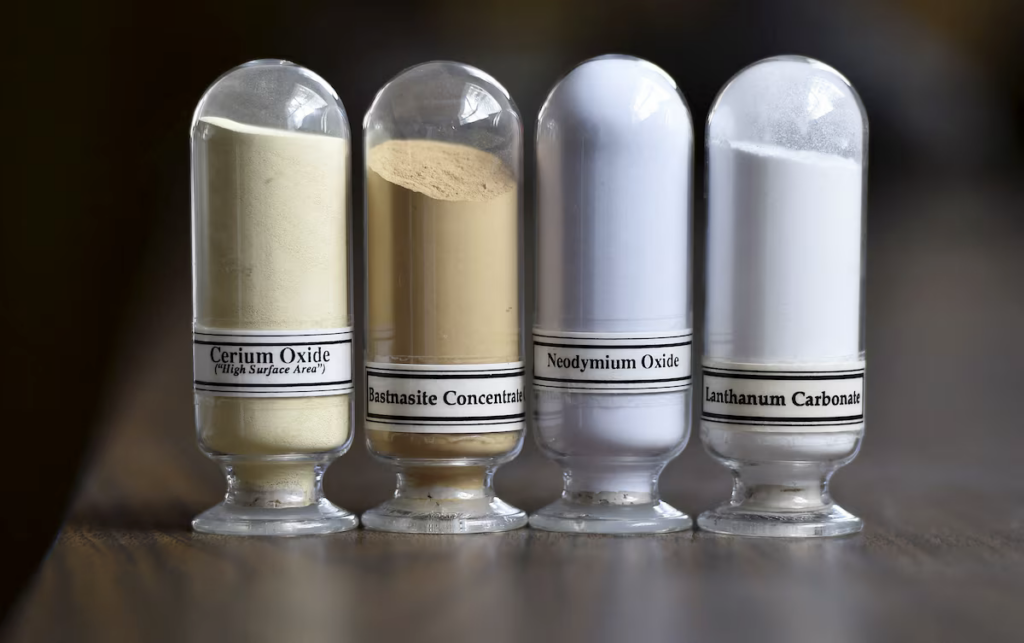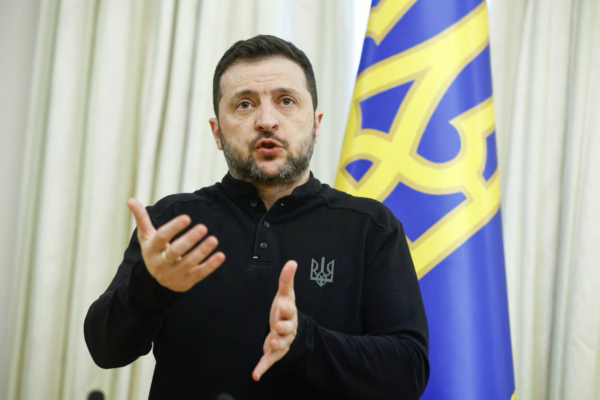Ukraine’s President Volodymyr Zelenskiy speaks during a press conference, amid Russia’s attack on Ukraine, in Kyiv, Ukraine February 26, 2025. REUTERS/Valentyn Ogirenko
Ukraine said on Wednesday it had reached a “preliminary” deal to hand revenue from some of its mineral resources to the United States, before an expected trip to Washington by President Volodymyr Zelenskiy on Friday.
The deal is central to Ukrainian attempts to ensure strong support from U.S. President Donald Trump as he seeks a quick end to Russia’s war in Ukraine, with U.S.-Russian talks that have so far excluded Kyiv set to continue on Thursday.
“The main thing for me is we are not debtors. There is no $500 billion debt in the agreement, nor $350, nor $100 billion because that would be unfair,” Zelenskiy told a news briefing of the agreement.
Trump has cast the deal as a repayment for billions of dollars in aid to Kyiv during the war. Zelenskiy has been asking for security guarantees in exchange for the mineral rights, but it is unclear whether those demands have been successful.
“This agreement is part of our larger agreements with the United States. This agreement could be part of future security guarantees… an agreement is an agreement, but we need to understand the broader vision,” Zelenskiy said.
“This deal could be a great success or it could pass quietly. And the big success depends on our conversation with President Trump.”
Ukrainian Prime Minister Denis Shmyhal said Washington would commit to supporting Kyiv’s efforts to obtain security guarantees under the finalised deal, but the Americans offered no security pledges of their own.
While discussions have been taking place on the minerals deal, Washington and Moscow have begun bilateral talks.
Russian Foreign Minister Sergei Lavrov said Thursday’s talks in Istanbul would be on resolving bilateral disputes that are part of a wider dialogue the sides see as crucial to ending the Ukraine war.
‘VERY BIG DEAL’
Trump told reporters on Tuesday that Zelenskiy wanted to come to Washington on Friday to sign a “very big deal“.
Shmyhal said Ukraine’s government would authorise the agreed wording later on Wednesday so it could be signed. He described it as a “preliminary” agreement.
“After the Ukrainian president and the U.S. president agree on security guarantees, agree on how we tie this preliminary agreement to security guarantees from the United States for our country, in the presence of (both) presidents, a representative of the Ukrainian government will sign this preliminary agreement,” he said.
A copy of a draft agreement, seen by Reuters and dated February 25, said: “The Government of the United States of America supports Ukraine’s efforts to obtain security guarantees needed to establish lasting peace.”
Shmyhal, outlining the agreement in televised comments, said Kyiv would contribute 50% of “all proceeds received from the future monetisation of all relevant state-owned natural resource assets and relevant infrastructure.”
Those proceeds would go into a fund under the joint control of the United States and Ukraine, he said, adding that no decision about the governance of the fund could be taken without Kyiv’s agreement.
“Already existing deposits, facilities, licenses and rents are not subject to discussion when creating this fund,” he added.
What are rare earth metals and why are they in demand?

Samples of rare earth minerals from left, Cerium oxide, Bastnasite, Neodymium oxide and Lanthanum carbonate are on display during a tour of Molycorp’s Mountain Pass Rare Earth facility in Mountain Pass, California June 29, 2015. REUTERS/David Becker/File Photo
Rare earth metals are making headlines as demand rises for products from smartphones to wind turbines, and as governments seek secure supply.
Here are some basic facts about them:
WHAT ARE THEY? Rare earths are a group of 17 elements including 15 silvery-white metals called lanthanides, or lanthanoids, plus scandium and yttrium.
WHAT ARE THEY USED FOR? They are used in a wide range of products including consumer electronics, electric vehicles (EVs), aircraft engines, medical equipment, oil refining, and military applications such as missiles and radar systems. WHAT COUNTRY IS THE BIGGEST PRODUCER? China accounts for about 60% of global mine production and 90% of processed and permanent magnet output. Beijing sets quotas on output, smelting, and separation, which are closely monitored as a barometer of global supply.
WHAT ARE THEIR NAMES? In their periodic table order, they are: scandium, yttrium, lanthanum, cerium, praseodymium, neodymium, promethium, samarium, europium, gadolinium, terbium, dysprosium, holmium, erbium, thulium, ytterbium, and lutetium.
WHICH ONES ARE MOST COMMON? Lanthanum and cerium are among the most common rare earth metals. Lanthanum is used in camera lenses and lighting. Cerium is used in catalytic converters, which reduce combustion engine emissions.
Neodymium and praseodymium are in demand for permanent magnets used in EV motors and wind turbines.
ARE THEY RARE? They are not rare in the sense that they are uncommon; some are more common than lead, for example. But they tend to be spread thin around the Earth’s crust in small quantities and mixed together or with other minerals, so larger deposits are difficult to find and costly to extract.
WHAT ENVIRONMENTAL IMPACT DO THEY HAVE? Processing rare earths often involves the use of solvents, which can produce toxic waste that pollutes the soil, water, and atmosphere. More environmentally friendly technologies are being developed, but they are not yet widely used.
Certain types of rare earth ores also contain radioactive thorium or uranium, which is often removed using acid.
For this reason, development of the sector faces health and environmental regulatory hurdles.
REUTERS
